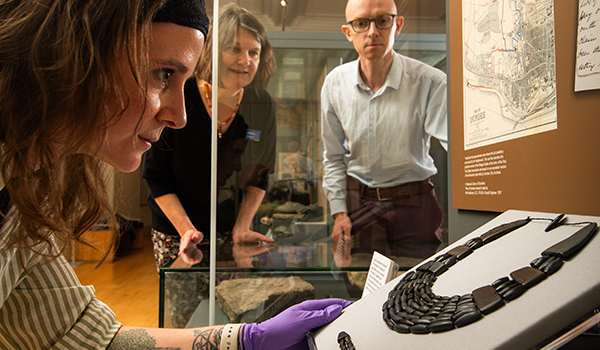
An early Bronze Age necklace and bracelet have been painstakingly restored by experts at National Museums Scotland. The jewellery can be seen in its original form for the first time in over 4000 years and is now on display at The McManus: Dundee’s Art Gallery & Museum.
Forty-two jet beads and nine jet ‘plates’ were discovered in a Bronze Age burial at the former Balgay Estate, near Dundee in 1870. At the time, the Balgay Estate extended as far as the shoreline of the River Tay. For over a century the loose beads were thought to come from a single piece of jewellery, but recent research by Dr Alison Sheridan, Research Associate at National Museums Scotland, has revealed they belong to a matching necklace and bracelet set. In-depth analysis has allowed conservators to accurately recreate 66 unique missing beads and restring the jewellery in its original Bronze Age formation.
The plates, which separate the barrel-shaped beads into multiple strands, are decorated with intricate bored dot designs. Such craftsmanship indicates that they were valuable pieces. The jet itself was an exotic raw material, imported from Yorkshire. Gentle wear on the larger plates shows the jewellery was frequently worn and treasured, most likely by a woman of status.
The jewellery will go on loan to Dundee from National Museums Scotland with the support of players of People’s Postcode Lottery. The necklace and bracelet will be displayed within the Landscapes and Lives gallery at The McManus. This gallery explores the natural landscape of Dundee from an early geological age and highlights the lives of people in the Tay valley from the Mesolithic period to the Iron Age.
Matthew Knight, Senior Curator of Prehistory at National Museums Scotland, said:
“We’re delighted to be loaning this exceptional necklace and bracelet to The McManus. The painstaking work undertaken by National Museums Scotland researchers and conservators has been truly special and allows us to travel back in time and experience these important Bronze Age objects as they would have been seen thousands of years ago. Through collaboration with colleagues from Leisure & Culture Dundee, we can now explore the previously untold story of the Balgay burial. We’re grateful for the generous support of players of People’s Postcode Lottery, which allows National Museums Scotland to continue to share the National Collection with audiences across the country, bringing these remarkable moments in Scottish history to life in a tangible and inspiring way.”
Christina Donald, Curator of Early History at Leisure & Culture Dundee, said:
"We look forward to welcoming the Balgay jet jewellery to Dundee for our museum visitors to see on display for the first time. We highly value the partnership that has made this possible. Thanks to the expertise and generosity of National Museums Scotland, we can showcase the jewellery and reveal the results of in-depth scientific research to shed light on these important artefacts. Documentary study by volunteers from Abertay Historical Society and Friends of Balgay Park has also helped us share the story of the re-discovery of this necklace and bracelet more than 100 years ago by the banks of the Tay."
This loan is part of National Museums Scotland’s National Strategy, which sees collections and expertise shared through loans, participation in national projects, community engagement, funding for acquisitions and free knowledge and skills development opportunities for museums across Scotland. Over 2500 objects are currently on loan to Scottish organisations, bringing the National Collection to audiences across the country.
Pictured:
Conservator Bethan Bryan, Curator Christina Donald and Senior Curator Dr Matthew Knight, and put the finishing touches to the display of a 4,000-year-old Bronze Age Necklace and bracelet at The McManus in Dundee. The jewellery was discovered on the former Balgay Estate near Dundee in 1870, and has been painstakingly conserved by experts at National Museums Scotland.
Photographer credit: Alan Richardson
